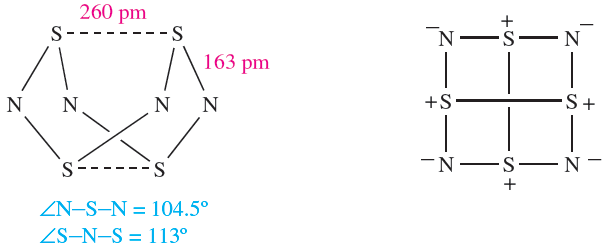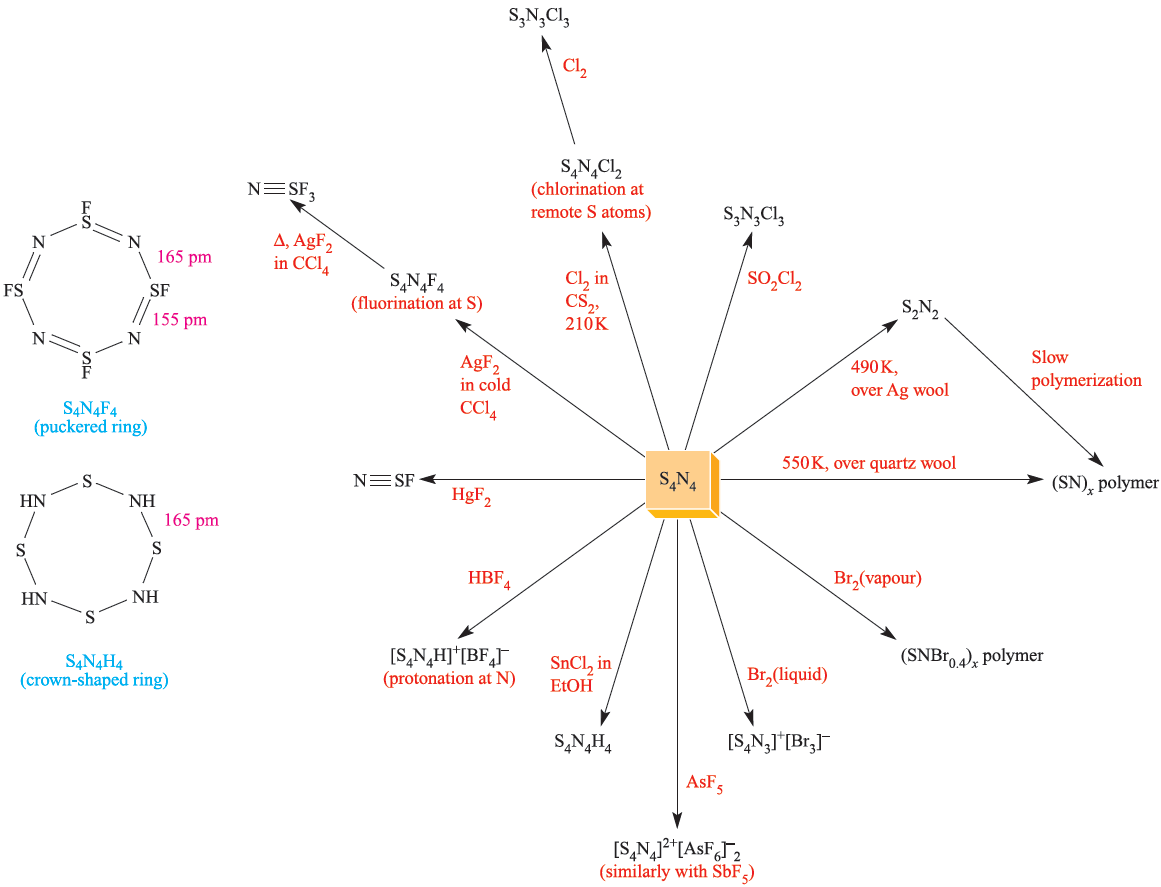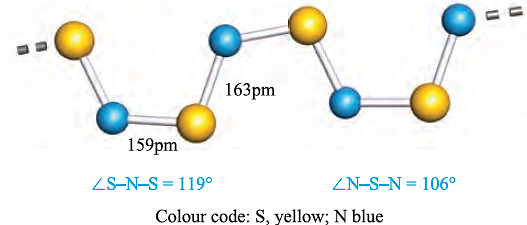


 علم الكيمياء
علم الكيمياء 
 الكيمياء التحليلية
الكيمياء التحليلية 
 الكيمياء الحياتية
الكيمياء الحياتية 
 الكيمياء العضوية
الكيمياء العضوية 
 الكيمياء الفيزيائية
الكيمياء الفيزيائية
 الكيمياء اللاعضوية
الكيمياء اللاعضوية 
 مواضيع اخرى في الكيمياء
مواضيع اخرى في الكيمياء
 الكيمياء الصناعية
الكيمياء الصناعية |
Read More
Date: 17-11-2020
Date: 8-3-2019
Date: 20-5-2020
|
Sulfur–nitrogen compounds
Sulfur–nitrogen chemistry is an area that has seen major developments over the last few decades, in part because of the conductivity of the polymer (SN)x. The following discussion is necessarily selective, and more detailed accounts are listed at the end of the chapter. Probably the best known of the sulfur–nitrogen compounds is tetrasulfur tetranitride, S4N4. It has traditionally been obtained using reaction 1.1, but a more convenient method is reaction 1.2. Tetrasulfur tetranitride is a diamagnetic orange solid (mp 451 K) which explodes when heated or struck; pure samples are very sensitive. It is hydrolysed slowly by water (in which it is insoluble) and rapidly by warm alkali (equation 1.3).
 (1.1)
(1.1)
 (1.2)
(1.2)
 (1.3)
(1.3)
The structure of S4N4, 1.1, is a cradle-like ring in which pairs of S atoms are brought within weak bonding distance of one another (compare with ½S8_2, Figure 15.7). The S_N bond distances in S4N4 indicate delocalized bonding with π-contributions (compare the S_N distances of 163pm with the sum of the S and N covalent radii of 178 pm). Transfer of charge from S to N occurs giving Sδ+__Nδ- polar bonds. A resonance structure for S4N4 that illustrates the cross-cage S_S bonding interactions is shown in 1.2.

(1.1) (1.2)
Figure 15.18 gives selected reactions of S4N4; some lead to products containing S_N rings in which the cross-cage interactions of S4N4 are lost. Reduction (at N) gives tetrasulfur tetraimide, S4N4H4, which has a crown-shaped ring with equal S_N bond lengths. Tetrasulfur tetraimide is one of a number of compounds in which S atoms in S8 are formally replaced by NH groups with retention of the crown conformation; S7NH, S6N2H2, S5N3H3 (along with S4N4 and S8) are all obtained by treating S2Cl2 with NH3. No members of this family with adjacent NH groups in the ring are known.

(1.3) (1.4)
Halogenation of S4N4 (at S) may degrade the ring depending on X2 or the conditions (Figure 15.18).

Fig. 15.18 Selected reactions of S4N4; the rings in S4N4H4 and S4N4F4 are non-planar.
The ring in S4N4F4 has a puckered conformation quite different from that in S4N4H4. Fluorination of S4N4 under appropriate conditions (Figure 15.18) yields thiazyl fluoride, NSF, 1.3, or thiazyl trifluoride NSF3, 1.4, which contain SN triple bonds (see problem 15.25a at the end of the chapter). Both are pungent gases at room temperature, and NSF slowly trimerizes to S3N3F3; note that S4N4F4 is not made from the monomer. The structures of S3N3Cl3 (1.5) and S3N3F3 are similar. The rings exhibit only slight puckering and the S_N bond distances are equal in S3N3Cl3 and approximately equal in the fluoro analogue. Oxidation of S4N4 with AsF5 or SbF5 gives [S4N4][EF6]2 (E = As or Sb) containing [S4N4]2+. This has the planar structure 1.6 in many of its salts, but [S4N4]2+ can also adopt a planar structure with alternating bond distances, or a puckered conformation. The [S4N3]+ cation (prepared as shown in Figure 15.18) has the planar structure 1.7 with delocalized bonding.

(1.5) (1.6) (1.7)
The S4N4 cage can be degraded to S2 N2 (Figure 15.18) which is isoelectronic with [S4]2+, S2N2 is planar with delocalized bonding (S_N = 165 pm), and resonance structures are shown in 1.8. At roomtemperature, this converts to the lustrous golden-yellow, fibrous polymer (SN)x, which can also be prepared from S4N4. The polymer decomposes explosively at 520 K, but can be sublimed in vacuo at ≈ 410 K. It is a remarkable material, being covalently bonded but showing metallic properties: a one-dimensional pseudo-metal. It has an electrical conductance about onequarter of that of mercury in the direction of the polymer chains, and at 0.3K it becomes a superconductor. However, the explosive nature of S4N4 and S2N2 limits commercial production of (SN)x, and new routes to (SN)x or related polymers are goals of current research. In the solid state, X-ray diffraction data indicate that the S_N bond lengths in (SN)x alternate (159 and 163 pm) but highly precise data are still not available; the closest interchain distances are nonbonding S S contacts of 350pm. Structure 1.9 gives a representation of the polymer chain and the conductivity can be considered to arise from the unpaired electrons on sulfur occupying a half-filled conduction band .

(1.8)

(1.9)
The reactions of S7NH with SbCl5 in liquid SO2, or S3N3Cl3 with SbCl5 and sulfur in SOCl2, lead to the formation of the salt [NS2][SbCl6] containing the [NS2]+ ion, (1.10) which is isoelectronic (in terms of valence electrons) with [NO2].

(1.10)



|
|
|
|
دراسة: عدم ترتيب الغرفة قد يدل على مشاكل نفسية
|
|
|
|
|
|
|
علماء: تغير المناخ تسبب في ارتفاع الحرارة خلال موسم الحج
|
|
|
|
|
|
|
ضمن مؤتمر الإمام الرضا (عليه السلام) العلمي بحث علمي يتناول الإرشادات التربوية في فكر الإمام الرضا (عليه السلام) وآثارها الاجتماعية
|
|
|